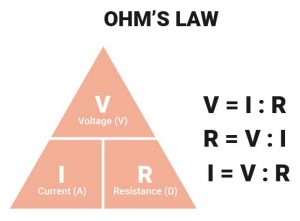If you will excuse the pun, it is difficult to “conduct” a conversation about electrical circuit design for very long, without venturing onto the topic of Ohm’s Law.
What Is Ohm’s Law?

Named after the German physicist Georg Ohm (1789-1854) – who, in a treatise dating to 1827, described measurements of applied voltage and current through simple electrical circuits in which a variety of wire lengths were used – Ohm’s Law plays a fundamental role in electrical circuit design to this day.
According to Ohm’s Law, the voltage across a conductor is directly proportional to the current flowing through it, presuming that all physical conditions – such as temperature – stay constant.
Introducing The Formulas for Ohm’s Law Calculations
From a mathematical standpoint, Ohm’s Law states that V = IR, where V is the potential difference or voltage, I is the current, and R is the conductor’s resistance.
You can read more about the formulas for Ohm’s Law on the website of the electronic component supplier RS Online, which also provides a simple tool to apply Ohm’s Law in electrical circuit design projects.
4 Ways in Which Ohm’s Law Is Applied in Contemporary Circuit Design

The straightforward, yet powerful relationship between voltage, current, and resistance that Ohm’s Law provides has made it extremely useful and relevant across a broad range of practical applications.
Below are some examples of them.
1. The Calculation of Component Values
Whether an electrical engineer is attempting to determine current flow, select resistors, or calculate voltage drops across a circuit’s components, Ohm’s Law can play a critical role.
It is greatly useful in the design process for consumer electronics, for instance, encompassing the likes of home automation systems and Internet of Things (IoT) devices.
Across projects like these, it is crucial to ensure that such components as sensors, transistors, and LEDs operate within safe limits.
2. The Optimisation of Power Management
The use of Ohm’s Law alongside the power formula P = V x I, assists the process of designing power supplies by calculating load requirements and making sure components can handle the current.
The next time you reach for your laptop or electric vehicle (EV) charger, it is worth taking a moment to consider how much diligent work must have been done to create that product, drawing upon Ohm’s Law across such areas as voltage regulation and current limiting.
3. The Analysis and Troubleshooting of Circuit Malfunctions
If a circuit isn’t working correctly, it might not be obvious at first whether the fault has occurred as a result of insufficient voltage, excessive resistance, or an unanticipated current drop.
Ohm’s Law enables the cause of such malfunctioning to be determined when it is used to compare expected versus actual voltage, current, or resistance values.
4. The Enhancement of Battery and Energy Efficiency
Many of us certainly take for granted the existence and usefulness of all manner of portable devices in our lives.
Indeed, you might not have known about or fully appreciated how Ohm’s Law is used by engineers to design circuits that minimise power loss and boost battery life in such devices.
Renewable energy projects certainly benefit from Ohm’s Law too, when it comes to the optimisation of power transfer efficiency in solar panels and battery storage systems.
Through applications like these and many more, Ohm’s Law continues to show it is utterly indispensable in even the latest and most sophisticated electrical circuit design projects.
Author Profile

- Informed content writer and creator in the UK, always on the lookout for new stories, developments and trends to share.
Latest entries
 Business AdviceDecember 2, 20254 Cost Management Strategies for Transport Business Owners
Business AdviceDecember 2, 20254 Cost Management Strategies for Transport Business Owners BusinessNovember 13, 2025Why Hiring Security Services Could Be Your Best Business Decision
BusinessNovember 13, 2025Why Hiring Security Services Could Be Your Best Business Decision EducationNovember 12, 2025How to Turn Exam Mistakes into Motivation for Success
EducationNovember 12, 2025How to Turn Exam Mistakes into Motivation for Success EntertainmentNovember 5, 2025Crucial Online Gaming Technologies Impacting the User Experience
EntertainmentNovember 5, 2025Crucial Online Gaming Technologies Impacting the User Experience


